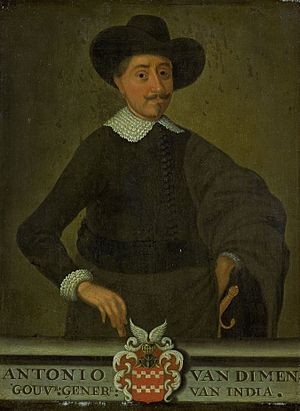Anthony van Diemen facts for kids
Quick facts for kids
Anthony van Diemen
|
|
|---|---|

Portrait of Anthony van Diemen
|
|
| Governor-General of the Dutch East Indies | |
| In office 1636–1645 |
|
| Preceded by | Hendrik Brouwer |
| Succeeded by | Cornelis van der Lijn |
| Personal details | |
| Born | 1593 Culemborg, Utrecht, Dutch Republic |
| Died | 19 April 1645 (aged 51–52) Batavia, Dutch East India |
| Nationality | Dutch |
| Occupation | Explorer, colonial governor |
Anthony van Diemen (born 1593 – died 19 April 1645) was an important Dutch colonial governor. He is best known for encouraging the exploration of Australia and Tasmania.
He was born in Culemborg, in the Netherlands. In 1616, he moved to Amsterdam to become a merchant. However, he faced financial difficulties. A year later, he joined the Dutch East India Company. This company was a powerful trading group. He sailed to Batavia, Dutch East Indies (which is now Jakarta), the capital of the Dutch East Indies. During his journey, his ship, the Mauritius, accidentally landed on the unknown coast of Australia.
Contents
Rising Through the Ranks
The governor at the time, Jan Pieterszoon Coen, saw that van Diemen was a very skilled official. By 1626, Anthony van Diemen became a top leader in charge of trade. He also joined the main council for the Indies. In 1630, he married Maria van Aelst. A year later, he returned to the Netherlands as an Admiral on a ship called Deventer.
In 1633, while sailing back to the Indies, van Diemen saw an island. He named it Amsterdam Island. He named it after his ship at the time, the Nieuw Amsterdam.
Governor-General
In 1635, Anthony van Diemen was chosen for a very important job. He became the Governor-General of the Dutch East Indies. He officially started this role on January 1, 1636.
His nine years as Governor-General were very successful. They were important for both the colony and the Dutch East India Company. He worked hard to make the company stronger. He helped expand its power across Southeast Asia. Under his leadership, the Dutch gained control in places like Sri Lanka (then called Ceylon).
Exploring the Great South Land
Van Diemen is most famous for his efforts to explore the "Great South Land." This land is now known as Australia. He encouraged many important Dutch sea journeys during his time.
Just three months after he arrived in Batavia, he sent out the first exploration trip. The ships started from Cape York. Their goal was to map unknown coasts. However, this trip failed when its leader was sadly killed in New Guinea. The ships then returned.
In 1639, he sent two more voyages to the north. They were looking for "Gold and Silver Islands." Spanish reports said these islands were east of Japan. He also sent Maarten Gerritsz Vries to explore the coasts of Korea and a region called "Tartaria." These trips also did not find what they were looking for.
But van Diemen did not give up. He asked Frans Visscher to create a plan for new discoveries. Visscher drew up three different routes. In August 1642, van Diemen decided to send Abel Janszoon Tasman. Tasman was joined by Visscher. Their mission was to find the Great South Land. Tasman would later name this land "Nieuw Holland."
Discovering Tasmania
In November 1642, Tasman was sailing east from Mauritius. He missed the south coast of the Australian continent. Instead, he saw land at what is now the west coast of Tasmania. He followed the coastline around to the east. Tasman sent a group ashore at Blackman Bay. They planted a flag and met some Tasmanian people. Tasman believed he had found a large new territory. He named it Van Diemen's Land to honor his boss, Anthony van Diemen.
Legacy and Commemorations
Anthony van Diemen is also remembered in other places. The Van Diemen Gulf on the coast of northern Australia is named after him. He also asked Tasman to make another voyage in 1644.
Van Diemen passed away in 1645 in Batavia, Dutch East Indies. The Dutch East India Company gave his wife a large pension. She then moved back to the Netherlands.
His wife, Maria van Aelst, is also remembered. Cape Maria van Diemen in New Zealand is named after her. Tasman named it in 1643. Maria Island off the east coast of Tasmania is also named after her. These are two of the only places in New Zealand that still have the names Tasman gave them. The other is Three Kings Islands.
Van Diemen also gives his name to Fort Antonio. This fort is in modern-day Tamsui in northern Taipei, Taiwan. The Dutch built it on the site of an old Spanish fort.
In 1842, a type of venomous snake was named in his honor. This snake genus, Demansia, is found in Australia and New Guinea. It was named by John Edward Gray of the British Museum.
See also
 In Spanish: Anthony van Diemen para niños
In Spanish: Anthony van Diemen para niños

